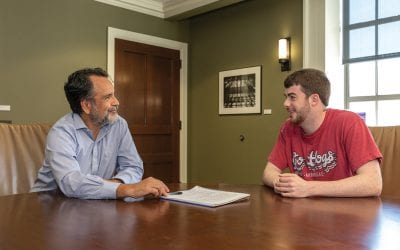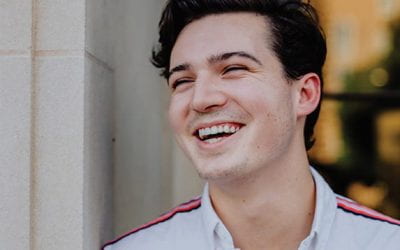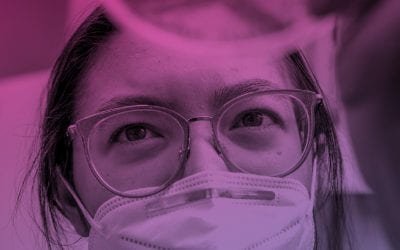
Love Your Back? Take a Break!
By Hiba Tahir
Photos by Russell Cothren
 Sitting down may be hazardous to your health. Those who spend several hours a day in seated positions — which, in the last year or two, is most of us, thanks to the COVID-19 pandemic — may find themselves struggling with lower back pain.
Sitting down may be hazardous to your health. Those who spend several hours a day in seated positions — which, in the last year or two, is most of us, thanks to the COVID-19 pandemic — may find themselves struggling with lower back pain.
“It doesn’t matter who you are,” said Lizeth Martinez Lopez, a Path Scholar majoring in kinesiology. “Your neck and back will probably be irritated if you spend a lot of time sitting.”
Most, it seems, are intrinsically aware of this — but it can be difficult to change seating habits. Martinez Lopez herself isn’t immune to the temptation to continue working long hours without breaks. “I do have back pain,” she admitted. “People think if you’re younger, you don’t experience it, but that’s not true. Sometimes, my back and neck are super strained.”
“Your neck and back will probably be irritated if you spend a lot of time sitting.”
After realizing she herself was suffering from the effects of improper seating practices, Martinez Lopez decided to center her thesis on the question of whether taking frequent walking breaks might help combat lower back pain, and if so, what speed of walking would be most effective. “Gait analysis is super complex, and there’s a lot of factors that definitely affect the way we walk,” she explained.
The movement of your arms, the way your back is positioned, the way your hips move, and whether you take the elevator or the stairs can all impact the way you walk. “Specifically, the lumbar flexion is something that I focus on, and this is what decreases lower back pain,” Martinez Lopez said. “If your lumbar is flexed and extended, you’re able to relieve pressure from your lower back, especially the lower lumbar spine.”
Originally, Martinez Lopez had planned to examine the gait of 30 participants, but social distancing guidelines introduced in response to the COVID-19 pandemic made it difficult to gather so many people in the lab. “We’re not able to socially distance, and if we’re having multiple people come in, disinfecting in between sessions is going to be difficult,” she explained.
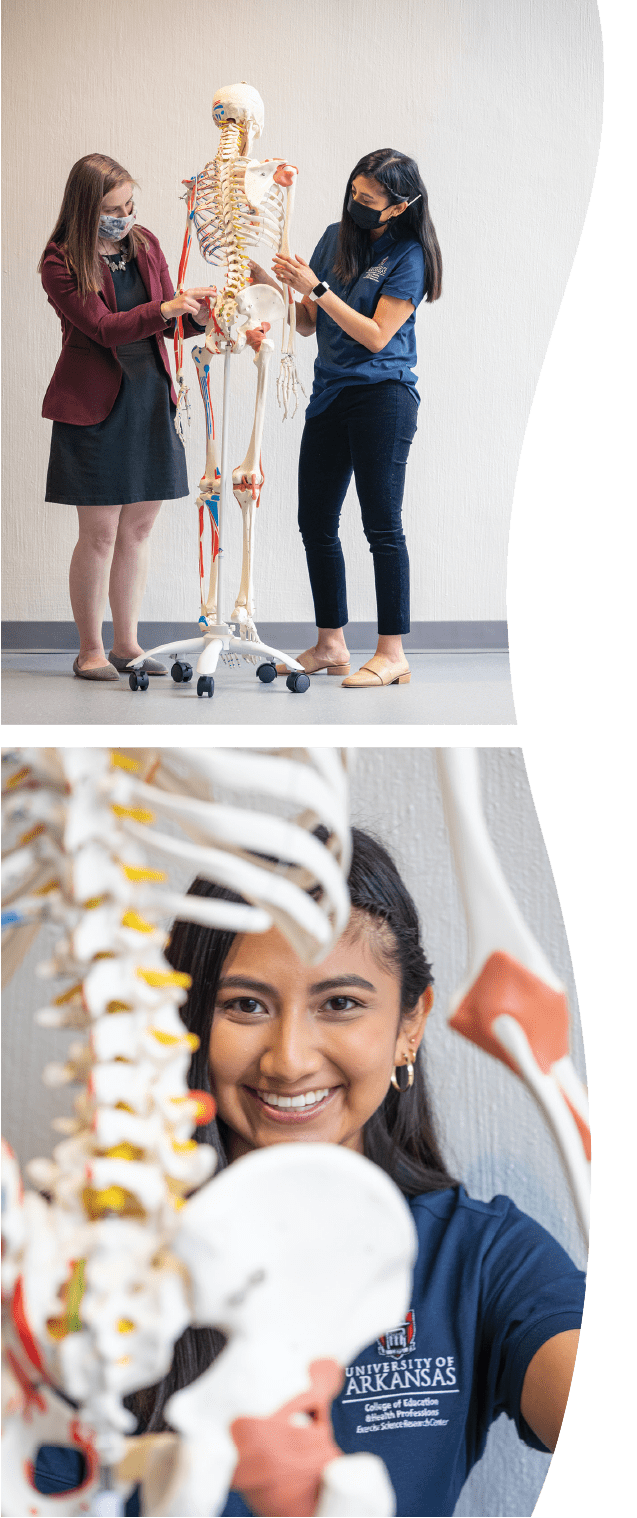
She decided to switch over to an online survey instead, which provided an unforeseen benefit. “More often than not, I think people can be super comfortable with describing their experiences on a web survey,” she said. “Just because it’s a little more anonymous.”
In her analysis of the online survey’s results, Martinez Lopez discovered that, in the three months prior to the study’s conclusion, 42% of students reported pain in the shoulder, neck or upper back, 39% reported pain in the low back, and 58% of those reporting pain reported taking medication for that pain.
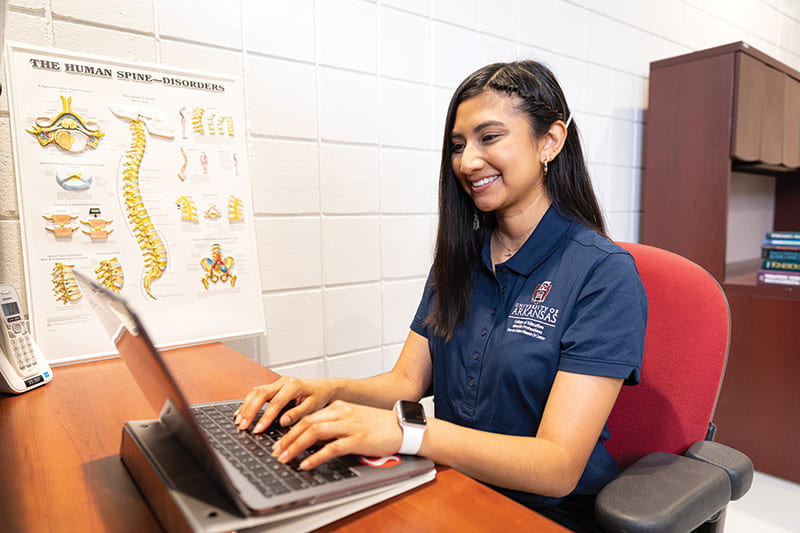 As she analyzed her results, Martinez Lopez was surprised to learn that she herself was falling into bad habits. She came up with some quick ways to deal with the pressure in her neck and back. “I think it’s surprising to see that even a minute or two or five of walking in between whatever it is you’re doing will relieve pressure from your back and make it so you’re able to concentrate more on what you’re doing,” she said. “I thought it would take like 30 minutes, or 15. But it really is just a matter of being conscious [of pain]. I think it’s also surprising to see that a lot of people don’t do anything; they just kind of shift their way over or flex their back a little bit and then just sit in that spot for a longer time. But even just a little break can go a long way, especially in the long term.”
As she analyzed her results, Martinez Lopez was surprised to learn that she herself was falling into bad habits. She came up with some quick ways to deal with the pressure in her neck and back. “I think it’s surprising to see that even a minute or two or five of walking in between whatever it is you’re doing will relieve pressure from your back and make it so you’re able to concentrate more on what you’re doing,” she said. “I thought it would take like 30 minutes, or 15. But it really is just a matter of being conscious [of pain]. I think it’s also surprising to see that a lot of people don’t do anything; they just kind of shift their way over or flex their back a little bit and then just sit in that spot for a longer time. But even just a little break can go a long way, especially in the long term.”
She suggests propping your laptop up on a higher surface so that your neck is level with it and your back can straighten out a little more. Other tips include using a raised desk and taking indefinite breaks — maybe, to use a distant bathroom. “If you’re in a building, sometimes it’s convenient to just go to the nearest bathroom, so you don’t really get that break,” she explained. “So be conscious of your surroundings and know that it’s okay to even just stand up and stretch from time to time.”
Martinez Lopez was directed by Kaitlin Gallagher, assistant professor of health, human performance and recreation, who challenged her to look beyond her initial proposal. “Dr. Gallagher sent me so many articles not solely relating to your spine, but also ergonomics in general,” she said. “She expanded my perspective on how big this proposal [could be] and how far we could really assist people, even outside the University of Arkansas.”
This fall, Martinez Lopez will be attending the physical therapy program at University of Arkansas for Medical Sciences and pursuing a doctorate degree in physical therapy. She hopes to serve underrepresented communities in Northwest Arkansas, with a particular focus on the Latinx community. “I’m super excited to be going into work and serving these underrepresented communities because I know there’s a language barrier, especially within the healthcare system,” she explained. “It’s so important for patients to understand fully the diagnosis, prognosis and everything that is going on. I’m really passionate and motivated to be an advocate for people who might face language barriers to get the best care that they can.”
More Field Notes
Goodwill Job Hunting
By Katie Wilson PowellPhotos by Chieko Hara For Jimmy Donlon, a senior marketing and management major and Honors College fellow, serving the community has meant being a part of the community throughout his entire life. Donlon’s father, a physician, founded a network...
Power Plays
By Kendall CurleePhotos by Beau Burris“The grand scale of both Versailles and D.C., built to awe and impress, gets the job done.”Washington, D.C. Satellite imagery © Google Earth Versailles, France. Satellite imagery © Google Earth Beau Burris has been obsessed with...
The Monster She Made
Image: Leigh Caruthers PrasselBy Hiba TahirPhotos by Chieko HaraWhen a family member was diagnosed with Ewing’s sarcoma, a rare form of bone cancer, Morgan Walker, an English major from Prairie Grove, saw many similarities between the grim prognosis and the plight of...
Prime Time for Gene Editing
Mary Jia searches for bacteria colonies that contain the plasmid needed to construct the gene-editing tool she’s designingBy Katie Wilson PowellPhotos by Chieko Hara Mary Jia, a biomedical engineering junior and Bodenhamer Fellow, has had her sights set on CRISPR...
Conscious Couture
By Hiba TahirPhotos by Hiba Tahir and Chieko Hara With normalcy beginning to return after months spent working from home, mostly in sweatpants, many are itching to refresh their wardrobes. Before you whip out your card for the latest trends, though, consider this:...


